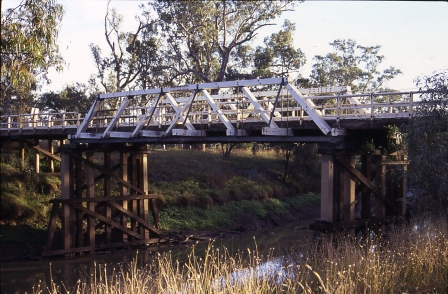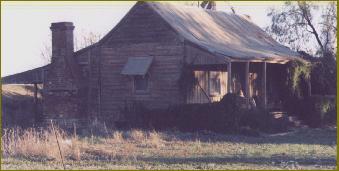Wee Waa is renowned as the oldest settlement along the meandering length of the Namoi River, bearing a history as unique and diverse as the area it encompasses. Although Wee Waa now sustains a diverse and powerful agricultural industry, the town initially grew out of the need for a centre of justice.
From as far back as 1846 Wee Waa serviced its locality and the greater region in all court and judicial matters. This was a role Wee Waa fulfilled for more than ten years before court proceedings were moved to nearby Narrabri and farther west to Walgett as more of the surrounding region became settled.
Although early development in the town stemmed from its legal involvement, Wee Waa soon became a supply centre for rural settlers in the vicinity. The main activity of the area was the grazing of cattle and sheep but as land was cleared and developed cereal crops became a valuable livelihood for rural families, and remain so today.
Old Bridge over the Namoi which is no longer there

The development of Wee Waa and district was further aided by the coming of the railway. Rail services were extended west from Narrabri, passing through Wee Waa to Walgett. The service was opened for use in 1901.
Timber cutting was an invaluable undertaking in the Pilliga Forest district. Much of the timber was used for the laying of the railway and for the construction of family dwellings. As many as 12 saw milling operations were open at any one time near the village of Gwabegar. Today one mill remains operational.
As the community evolved so did their desire to display and share their expertise and the productive capabilities of their area, hence the Wee Waa Show movement was initiated in 1912. Although good intent and support for a local show were in abundance, the circumstances of war and depression delayed the inaugural Wee Waa Show until 1927.
Wee Waa continued on its leisurely pattern of growth despite recurrent flooding and the annihilation of main street buildings by fire. Wee Waa was soon to acquire educational facilities, parks, retail outlets, pubs and clubs, sporting grounds and other facilities that go together to make a rural community a leisurely and social environment.
Shop Front of JJ Smith Saddler
(sent to me by his grandson Garry Smith)

It was in the early 1960's that the Californian influence plunged Wee Waa into an era of frenzied expansion. Recognising the untapped potential of the Wee Waa District, two Californian families, the Hadley's and the Kahl's made the move to Australia, bringing with them the expertise and technology of the American cotton industry. It was not long before other Wee Waa farmers cottoned on to cotton and as such cotton has become a major industry on a local, regional and national scale.
Today it is widely recognised that cotton and the Namoi Valley go hand in hand, earning Wee Waa its well deserved standing as the Cotton Capital of Australia. Together the people of the Namoi, and the industries they live by, deter the present day demise of the rural community and instead, not only sustain, but strengthen Wee Waa and the wider region's existence and future possibilities.
Wee Waa Historical Society have renovated Schwagers Cottage pictured below. They have erected a shed to house working machinery used in our past. The cottage is part of the museum You can find more about the museum Click here
The cottage where it stood
